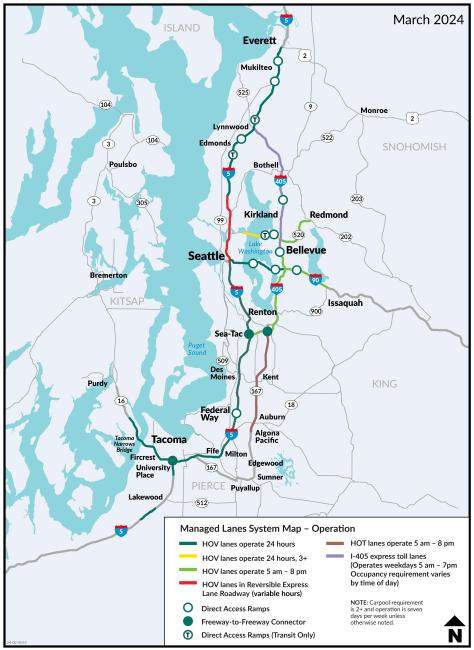HOV policy
Learn about the policies that govern the use of high occupancy vehicle (HOV) lanes, the State Route 167 High Occupancy Toll (HOT) lanes and the I-405 Express Toll Lanes.
HOV, high occupancy toll lanes and express toll lane policy objectives
In urban areas the demand for highway travel is greater than roads can accommodate, and traffic breaks down when the number of vehicles on the road exceeds capacity. HOV, HOT lanes and express toll lanes are strategies to maximize the movement of people on existing roadways by managing the number of vehicles in the lane to stay below capacity, providing more reliable speeds and increasing the advantage of using transit and high occupancy vehicles.
HOV, HOT lanes and express toll lanes users cite many benefits:
- Using HOV, HOT lanes or express toll lanes saves time, reduces stress, and is a more convenient way to travel.
- Travelling in an HOV, HOT lanes or express toll lane is usually faster than the other lanes, even when the lane is crowded.
- People who carpool, vanpool or ride transit can save money on their annual commute cost and may be able to live near more affordable housing.
- Every shared ride reduces the number of car trips on the overall transportation system and helps reduce the area’s contribution to greenhouse gasses, global warming and environmental health issues.
- Transit service provides faster service and lower operating costs when using HOV, HOT lanes and express toll lanes.
We are continually looking into ways to maximize efficiency to help keep people moving on our highways. HOV, HOT lanes and express toll lanes are part of a comprehensive approach to managing transportation systems efficiently.
Who can use an HOV, HOT lanes and express toll lanes
We create HOV lane policy based on federal and state law, as well direction from the Legislature to establish how and when drivers can use the lanes.
Express toll lanes and HOT lanes are special types of HOV lanes which allow drivers to pay a toll to use the lanes when they don’t meet the carpool requirements.
Under certain circumstances some drivers can travel toll-free in the express toll lanes or HOT lanes.
To be eligible for a toll-exempt trip in the express toll lanes or HOT lanes, the vehicle must have the correct number of occupants and be equipped with the appropriate Good To Go! pass. Learn more on the Good To Go! tolling program page.
Trucks weighing over 10,000 pounds GVW cannot use HOV, HOT lanes or express toll lanes.
The following table describes who can use the HOV lanes and who can use the express toll lanes and HOT lanes without paying a toll:
| Vehicles that can use HOV lanes | Vehicles that can use express toll lanes and HOT lanes toll-free |
|---|---|
| Any vehicle with the number of occupants indicated on signs (except trucks over 10,000 lbs. gross vehicle weight). | Any vehicle with the number of occupants indicated on signs (except trucks) if equipped with a Flex Pass set in the carpool position. |
| Motorcycles | Motorcycles equipped with a Motorcycle pass. |
| Public transportation vehicles | Public transportation vehicles, and vehicles with Rideshare license plates equipped with an exempt pass. |
| Buses with a capacity for 16 or more people. |
School buses with capacity for 16 or more people and equipped with an exempt pass. Private buses with capacity for 16 or more people, providing passenger service on a fixed route and schedule, and equipped with an exempt pass. Over-the-road coaches with capacity for 10 or more people, and equipped with an exempt pass. |
| Emergency vehicles and tow trucks enroute to an emergency on the roadway. | Authorized, on-duty emergency vehicles and tow trucks authorized by the Washington State Patrol. |
|
Vehicles with capacity for eight or more people registered as: |
Private nonprofit transportation providers with Rideshare plates. Private employer transportation service vehicles certified by WSDOT (considered private buses). |
|
Until June 30, 2023, unless extended by the Legislature, these vehicles are also allowed under a pilot programs:
|
HOV operating rules by location

HOV violations
HOV lanes, HOT lanes, and express toll lanes are less effective if ineligible vehicles use them. The Washington State Patrol enforces the lanes for compliance. Violating HOV rules can be expensive and becomes increasingly more expensive with repeated violations. For a first violation the fine is $186, and all subsequent violations within a two-year period increase to $336. If a doll or dummy is placed in the car, an additional $200 will be added to the fine.
Speed and reliability standards
We established performance standards in the 1990s to ensure the state's freeway HOV system helps provide reliable travel time and dependability for transit users, vanpoolers and carpoolers. A driver in an HOV lane should be able to maintain an average speed of 45 mph or greater at least 90 percent of the time during the morning and afternoon rush hour. This standard has since been endorsed in state and federal legislation.
For many years most Puget Sound HOV lanes have not met this performance standard. On I-405 and State Route 167, we introduced express toll lanes and HOT lanes, which charge drivers a toll rate that varies depending on traffic conditions to use the lanes. By introducing a dynamic toll, we now have additional tools to help manage congestion.
Slow down – lives are on the line.
In 2023, speeding continued to be a top reason for work zone crashes.
Even one life lost is too many.
Fatal work zone crashes doubled in 2023 - Washington had 10 fatal work zone crashes on state roads.
It's in EVERYONE’S best interest.
95% of people hurt in work zones are drivers, their passengers or passing pedestrians, not just our road crews.
